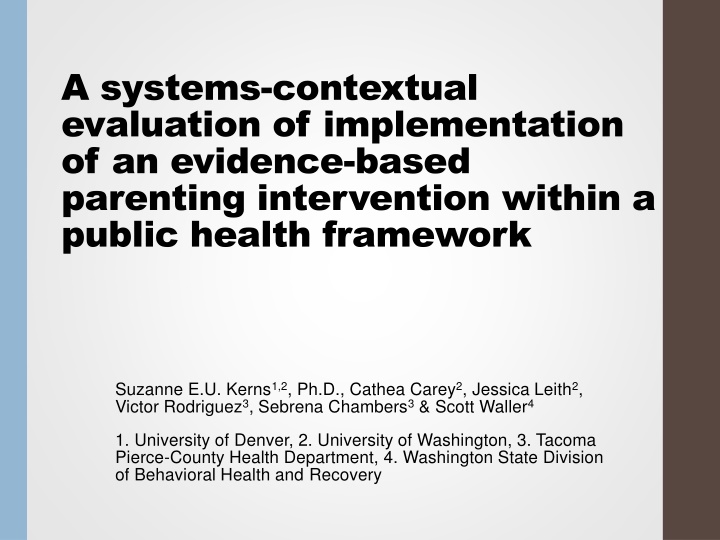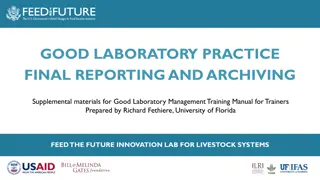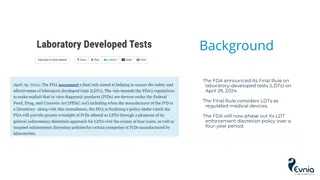
Systems-contextual Evaluation of Evidence-based Parenting Intervention
Explore the implementation of the Triple P Positive Parenting Program within a public health framework, focusing on enhancing parenting skills and reducing child maltreatment. Discover how the initiative impacts primary care physicians, training programs, and community systems to provide effective support for families.
Download Presentation

Please find below an Image/Link to download the presentation.
The content on the website is provided AS IS for your information and personal use only. It may not be sold, licensed, or shared on other websites without obtaining consent from the author. If you encounter any issues during the download, it is possible that the publisher has removed the file from their server.
You are allowed to download the files provided on this website for personal or commercial use, subject to the condition that they are used lawfully. All files are the property of their respective owners.
The content on the website is provided AS IS for your information and personal use only. It may not be sold, licensed, or shared on other websites without obtaining consent from the author.
E N D
Presentation Transcript
A systems-contextual evaluation of implementation of an evidence-based parenting intervention within a public health framework Suzanne E.U. Kerns1,2, Ph.D., Cathea Carey2, Jessica Leith2, Victor Rodriguez3, Sebrena Chambers3& Scott Waller4 1. University of Denver, 2. University of Washington, 3. Tacoma Pierce-County Health Department, 4. Washington State Division of Behavioral Health and Recovery
Triple P (Positive Triple P (Positive Parenting Program) Parenting Program) The Triple P Positive Parenting Program (Triple P) is a multi-level population based approach designed to enhance parenting skills and reduce child maltreatment (Sanders, 1999). One population-level study of Triple P showed that the Triple P system may move the needle on substantiated child maltreatment, child out-of-home placements, and child maltreatment injuries (Prinz et al., 2009). Prinz RJ, Sanders MR, Shapiro CJ, Whitaker DJ, Lutzker JR. Population-based prevention of child maltreatment: The US Triple P system population trial. Prevention Science. 2009 Mar 1;10(1):1-2. Sanders MR. Triple P-Positive Parenting Program: Towards an empirically validated multilevel parenting and family support strategy for the prevention of behavior and emotional problems in children. Clinical child and family psychology review. 1999 Jun 1;2(2):71-90.
W WA State Triple P Initiative A State Triple P Initiative Prior studies examined the systems-contextual factors associated with timely implementation of Triple P within three rural communities in Washington State (Kerns et al., in press) and the impact of Triple P training on PCPs (McCormick et al., 2014). The present study looked to: Increasing reach through collaborating with existing Triple P providers and training more providers Developing a large, robust network for provides in various family serving systems (including Primary Care) Establishing a robust referral system Evaluating outcomes at the provider and organizational level We emphasize the impact of this initiative on primary care physicians integrating parenting interventions into practice. Incentivizing PCPs and clinics with CMEs and Medicaid reimbursement McCormick E, Kerns SE, McPhillips H, Wright J, Christakis DA, Rivara FP. Training pediatric residents to provide parent education: a randomized controlled trial. Academic pediatrics. 2014 Aug 31;14(4):353-60. Kerns SEU, McCormick E, Negrete A, Carey C, Haaland W, Waller S. Predicting Post-training Implementation of a Parenting Intervention. Journal of Children s Services. 2017 Jun 19; (in press). Carey C, Leith JM, Kerns SEU. DSHS Triple P Final Evaluation Triple P Urban Initiative. Prepared for WA State Department of Social and Health Services. December 2016.
Triple P: Pierce County Triple P: Pierce County Initiative Initiative 19 participating organizations 15 completed organizational level data, 12 completed both time points 94 individuals participated in Triple P training. Level 2 Brief Primary Care 13 2 4 24 Level 2 Seminar* 9 Level 4 Standard** 17 Level 4 Group 17 Work Domain Home Visitor Public Health Nurse Daycare/School Primary Care Providers MH Practitioners Total number trained 8 15 32 2 51 17 19 *16 practitioners were trained in at least one other level of Triple P training and Level 2 Seminar. **7 practitioners were trained and accredited both in Level 4 Standard and Level 4 Group.
Capacity Building Capacity Building Systems contextual framework Diverse training populations and intervention Referral network Legacy with the Medicaid billing and ACA/AHCA
Current Study Current Study Network analysis N = 13 agencies Pre-post questionnaires 6 months apart Extent to which they share referrals and resources with other participating agencies Perceptions of collaborative capacity Outcome study N = 44 individual practitioners Baseline and 6-month follow-up questionnaires Domains assessed: model use, general attitudes towards EBPs, perception of acceptability and feasibility of Triple P, network communication and collaboration, availability of referral networks, and other supports for implementation Facilitators and barriers to implementation were collected qualitatively
Social Network Analysis Social Network Analysis The initiative had a positive impact in creating additional referral pathways within the Tacoma area between baseline (Figure 1) and at 6-month Follow-up (Figure 2). Figure 1. Figure 2.
Practitioner Delivery of Practitioner Delivery of Program and Impact Program and Impact Within first six months post-training, 25 out of 44 (57%) trained practitioners with implementation data indicated they went on to deliver the intervention Prior studies found a predictive relationship between EBP attitudes and service delivery. Attitudes of participants were positive at baseline. Perceptions of communication and collaboration between service providers remained relatively unchanged. All practitioner groups showed significant improvements in self-efficacy and confidence in program delivery over time. Practitioners reported moderate levels of satisfaction with the program. Trends showed an increase in the perception and feasibility of Triple P in all groups except Primary Care Providers. Home visitors and behavioral health practitioners were more likely to use the program compared with primary care physicians and those in non-traditional settings (e.g., librarians).
Predicting Implementation? Previous study found timely implementation could be predicted by baseline attitudes towards EBP and self-efficacy ratings immediately following training (Kerns et al., in press). In this project we focused on increasing SE and had higher scores on EBP attitudes. We intentionally addressed noted barriers indicated in prior implementation. Yet overall implementation rates were very similar. Exact logistic regression (DV: any implementation of TP within 6- months post-training) Satisfaction only predictor variable (OR 5.76).
Lessons Learned Lessons Learned Technology isn t always our friend Attempts to sync with EMR systems proved very challenging and overly time-consuming Solving seemingly large problems isn t always the key to successful implementation E.g., Medicaid reimbursement; referral system Despite strategically targeted implementation approaches, program uptake rates are hard to budge Matches rates found in other studies (e.g., Henggeler et al., 2008) Multiple measurement approaches are critical Self-report and network analysis tell different stories Embedding parenting interventions in primary care is incredibly challenging. It represents a task-shift from traditional approaches. Pragmatic implementation supports is essential. E.g., on-line referral strategy
Translating Research into Practice Translating Research into Practice Practice or Policy implications for my setting/stakeholders (context-specific) When developing a complex interdisciplinary initiative it s impossible for implementation leads to have expertise in all systems. Those with expertise in the systems may not have all necessary knowledge about the intervention. Thus, implementation approaches must be flexible, responsive, and iterative. Necessary policy changes take time and aren t always apparent at the beginning of a project. Adjust timelines and expectations accordingly. Practice or Policy implications beyond my setting/stakeholders (generalizable) Important factors in the literature may not have the same bearing on specific projects. Population-level initiatives are inherently complex; guidance from implementation science literature is variable for such complex initiatives. Policy makers and funders should support time and allocate resources to enable the iterative nature of implementation within complex initiatives.


![READ⚡[PDF]✔ Yup I'm Dead...Now What? The Deluxe Edition: A Guide to My Life Info](/thumb/20463/read-pdf-yup-i-m-dead-now-what-the-deluxe-edition-a-guide-to-my-life-info.jpg)

















